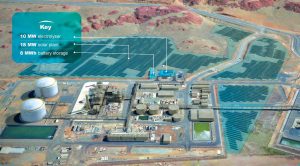Hydrogen deal unites Australian innovation with German expertise
Joint funding deal aims to stimulate innovation and cut costs around renewable hydrogen production.

Australia and Germany are boosting research into renewable hydrogen production with around $110 million combined conditional funding for four joint projects.
The agreement brings together Australian and German industry and research partners to deliver new projects, primarily based in Australia.
The main use of hydrogen is as a raw material for industry. At present, hydrogen is mostly derived from methane in an emissions intensive process. Renewable hydrogen could reduce emissions in what are known as hard-to-abate industries, and also some transport sectors.
The funding is part of the German-Australian Hydrogen Innovation and Technology Incubator, known as HyGATE. The initiative opened in March 2022 with Australia and Germany committing funding up to AU$50 million and €50 million respectively.
This round sees ARENA, on behalf of the Department of Climate Change, Energy, Environment and Water (DCCEEW), contributing $50 million.
Project Management Jülich (PtJ) is managing €40 million ($60 million) on behalf of Germany’s Federal Ministry of Education and Research (BMBF).
Global collaboration
HyGATE builds on both nations’ respective strengths. Australia is seen as a potential world leader in the production and export of clean hydrogen. Germany holds expertise in hydrogen technology and is planning to import significant amounts of hydrogen in the future.
Minister for Climate Change and Energy Chris Bowen MP says collaboration with Germany will help grow Australia’s vision of becoming a renewable energy superpower.
“These projects demonstrate Australia’s role as a world leader in renewable energy production, reducing the cost of hydrogen production and paving the way for exports,” he said.
ARENA CEO Darren Miller said the HyGATE Initiative brings together Australian innovation and state-of-the-art German renewable hydrogen technology.
“We’re excited to be able to announce the first four hydrogen projects we think best represent the possibilities of global collaboration to achieve a new export industry in renewable hydrogen and push us further towards the goal of net zero emissions,” he said.
Funding recipients have demonstrated their ability to deliver on one or more specified outcomes of the funding round, including:
- Demonstrating highly innovative technology across the value chain of renewable hydrogen.
- Reducing the cost of hydrogen production, transport, storage and use, and supporting the commercial viability of renewable hydrogen.
- Developing an Australian-German supply-chain for renewable hydrogen.
- Encouraging cross-country collaboration and knowledge sharing between Australian and German organisations.
- Providing price discovery and transparency in relation to the current and projected economics for renewable hydrogen technologies.
ScaleH2 project
ScaleH2 brings together Australian energy infrastructure operator ATCO in partnership with Germany’s Fraunhofer Institute for Surface Engineering and Thin Films.
The project presents a pathway to the development of a 1 GW electrolyser and 800 ktpa ammonia facility in the Illawarra region of NSW.
German researchers bring expertise in electrolyser efficiency, coating and plate technologies and underground storage solutions.
ScaleH2 aims to develop and execute a strategy for a hydrogen export value chain from NSW to German customers.
CFE-Pilot project

CFE-Pilot supports the demonstration of an innovative ‘capillary-fed’ electrolyser.
Australian hydrogen technology developer Hysata working with the Fraunhofer Institute for Production Technology will test the delivery of low-cost hydrogen in the Illawarra region.
The modular 200 kW electrolyser stack aims to achieve a high target efficiency of 95 per cent. The efficiency of a standard electrolyser is around 75 per cent.
The technology could see the overall, levelised cost of hydrogen cut below $2 per kilogram.
Hysata was spun out from the University of Wollongong where researchers, also supported by ARENA funding, developed the cell technology.
EGH2 project
EGH2 will deploy a 17.5 MW Siemens Energy electrolyser with 21 MW solar PV to produce renewable hydrogen for minerals processing and transport applications.
Australian renewable energy development firm Edify is negotiating an offtaker partnership which will demonstrate a strong level of innovation. The project also has the potential to impact the broader Australian-German supply chain.
The project will be delivered under a partnership between Edify Energy and Siemens Energy.
Solar Methanol project
Solar Methanol involves the development of a methanol production plant using concentrated solar power (CSP).
Australian solar thermal technology experts Vast Solar will develop the project in Port Augusta, South Australia.
The plant consists of a 10 MW electrolyser producing green hydrogen for solar methanol production.
It seeks to address emerging markets for sustainable shipping and aviation fuels, and also to power international industry and ensure domestic energy security.
Backing hydrogen

HyGATE is just the latest commitment in ARENA’s commitment to hydrogen. Over the past 10 years, ARENA has provided funding of $170.35 million to 44 hydrogen projects. More are in the pipeline.
In May 2022, Hysata reported its electrolyser breakthrough, which offers the prospect of producing hydrogen at $2 per kilogram. That would make hydrogen directly competitive with natural gas.
ARENA in September 2022 conditionally approved $47.5 million funding to build Australia’s first large scale renewable hydrogen plant. The $87 million Yuri project, led by global energy company ENGIE, will construct a 10 MW electrolyser and 18 MW of solar PV on the Burrup Peninsula in the Pilbara. Renewable hydrogen produced will supply the adjacent Yara Pilbara Fertiliser facility.
The funding is part of the $103.3 Renewable Hydrogen Development Round. The funding will support the Yuri project and two more 10 MW hydrogen electrolyser plants.
ARENA has also approved funding to Fortescue Future Industries for a FEED study for a 500 MW electrolyser at Gibson Island in Brisbane. The project would aim to fully decarbonise the existing Gibson Island ammonia plant owned by Incitec Pivot Limited (IPL).
And in December 2022, the ARENA-backed Central Queensland Hydrogen Project Feasibility Study concluded that a large -scale green hydrogen project in the Gladstone Region in Central Queensland could help launch a new low-carbon export industry for Australia.
LIKE THIS STORY? SIGN UP TO OUR NEWSLETTER

ARENA